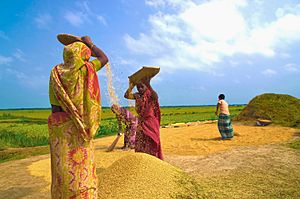Nabanna facts for kids
Nobanno (which means "New Feast") is a special harvest festival celebrated by Bengali people. It's a time for joy, food, dance, and music. This festival is popular in Bangladesh and in Indian states like West Bengal, Tripura, and Assam's Barak Valley. It's a big food festival where many traditional Bengali dishes, especially sweets and cakes called pitha, are made.
Celebrating the Harvest
Nobanno is celebrated with lively fairs called Nabanna Mela. People from all backgrounds in villages join in the fun. Many creative people, like poets, musicians, and artists, come together for these gatherings.
In modern times, the "Nabanna" festival is celebrated every Bengali year on the first day of the month of Agrahayan. In Dhaka, Bangladesh, the Jatiya Nabanna Utshab Udjapan Parshad (National Harvest Festival Committee) has organized it since 1998. It's a day-long event filled with many cultural activities.
Fun Activities at the Mela
People from different villages and districts come to the Nabanna Mela. They don't just visit; they also take part in many cultural programs and friendly competitions. Some popular activities include:
- Pithe Making: This is a competition to prepare different kinds of traditional Bengali cakes.
- Art Camp: Artists from various places come to create art.
- Exhibitions: You can see unique items from rural Bengal, like a "Dhenki" (an old-style rice mill) and different types of paddy (rice plants) directly from farmers.
You can also taste delicious Bengali dishes during the festival, such as Pati-Sapta, Payesh (a sweet rice pudding), and Jilipipi.
Music and Dance
The festival showcases Bengal's rich culture and heritage through various performances. Artists from different parts of the state perform their talents for thousands of people. Some of the traditional performances include:
- Baul songs: These are folk songs with deep spiritual meanings.
- Chhau dance: A vibrant, masked dance form.
- Jatra: A type of folk theater.
- Tarja and Kobi-gaan: These are traditional poetry and song contests.
You can also find stalls selling handicrafts made by rural artisans, which are perfect for collecting unique folk art.
Cultural Impact
The Nobanno festival has inspired many dance and music forms. For example, the Chhau dance and Bihu dance (though Bihu is more associated with Assam) have connections to harvest celebrations.
Nobanno is also linked to important cultural movements. A famous play called Nabanna was written about the sad Bengal Famine of 1943. This play helped people understand the struggles faced during that time and became a very important part of Bengali theatre.


